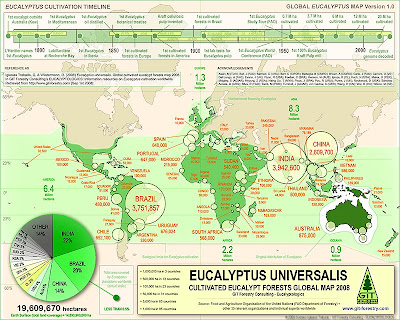30,000,000 new "invasive alien weed" trees... what a "catastrophe"... or not...
Gustavo Iglesias Trabado 
GIT Forestry Consulting SL - Consultoría y Servicios de Ingeniería Agroforestal - www.git-forestry.com - EUCALYPTOLOGICS - [Versión en Español, PDF 650 Kb]

GIT Forestry Consulting SL - Consultoría y Servicios de Ingeniería Agroforestal - www.git-forestry.com - EUCALYPTOLOGICS - [Versión en Español, PDF 650 Kb]

It is spring again in the Northern Hemisphere, and with it arrives the main tree planting season for 2011 in some of those areas of the world that, as Galicia in Northwestern Spain, devote significant annual public and private investments to the traditional cyclic production of organic, sustainable & renewable primary resources: timber crops.
After a historical top timber harvest during 2008 reaching 8 million cubic meters, year 2009 had seen a contraction of activity in which the effects of increased stormwood availability (Event Klaus) & the general effects of the global financial crisis and its aftermath on Spanish economy were two of the key factors. Year 2010 however was a recovery year for timber harvests, and the awaited start of the reactivation of local and regional timber trade was coincident with the entry of a noticeable amount of standing timber volumes, existent thanks to an ongoing for decades effort for the creation of planted forests, into the "harvestable age class".

Fig 1: Galicia is the Timber Reserve of Spain, and the source for 50% of Spanish yearly sustainable roundwood supply. A 95% of Galician yearly timber harvest is sourced from planted forests belonging to 600,000 families of Galician people who invest in sustainable natural resource production. A larger version of this graphic summary is available from GIT Forestry Consulting upon request (just contact us).
As a result, dozens of thousands of Galician family economies associated to tree crops cashed once more on their private investments in timber crops during 2010, and, after injecting part of that cash into the rural economies of the country, contributing once more to rural development, reserved part of their income to, once more, renew the sustainable production cycle of organic fibers that will become an array of different renewable and recyclable timber products in the next 10 to 30 years, while their act as carbon sinks, recycling solar energy and one of the concerning elements increasingly emitted by human activity worldwide into natural products.

Fig 2: Example of two generations of Galician tree growers assessing the performance of their Eucalyptus planted forests, established by private initiative in that area the Iberian Peninsula during a trend lasting 130 years, source of sustainable timber harvests for diverse end uses since establishment. (Click image to enlarge).
Apparently, during late 2010 and ongoing 2011 the demand for planting stock has skyrocketed compared to previous years, particularly for the main commercial timber producing species for a range of different industrial lines and which are at once generators of income to some 600.000 families of tree growers: several types of pine trees & several types of eucalypt trees. It seems very likely that Galician tree growers have decided to invest over 40 million € of their own during 2011 in eucalypt tree planting, which seems to be a blooming privately funded sustainable agrobusiness for some decades now, to the point that eucalypt tree planting has not been promoted by the injection of public subsidies in Galicia for over 20 years, while, during the same period, eucalypt logs harvested in Galicia have managed to become a 25% of total yearly harvested timber production for the whole of Spain.
Some of these magnitudes seem to have also excited the minds of an overwhelmingly minoritary amount of Galician & non Galician native peoples who, for an equivalent period of time, have been devoting their efforts and the money of donations & public subsidies to keep an artificially created social conflict alive: the random public promotion of a handful of selectively chosen options among an array of several dozen local crops based on the cultivation of non native plant & animal species adopted by Galician people along centuries as "the source of all evils". Nothing new, as that one is also a long time running business delivering wages or profit to an insignificant percent of the population of Spain, without it meaning a remotely significant injection of capital into the critically important populations of the regional rural economies, whose members are, by living in 2000 year old human-created landscapes, the only ones able to preserve them and/or modify them, and with them, their 2000 year old human-modified inherited biodiversity.

Fig 3: Up to five generations of Galician tree growers have, by private initiative, been continuously cultivating Eucalyptus planted forests for commercial timber production for at least 130 years, being one of the longest running existing examples worldwide of the long term sustainability of eucalypt tree farming, as the same or improved variations of the original crop management systems remain, in spite of recent rural abandonment, yet common in the same areas where they were first implemented. (Click image to enlarge).
So, a "30 million extra weeds" catchphrase, associated to false concepts, half truths, exaggerated non generalized truths, or plain lies was concocted once more to attempt a justification of the existence of non existent generalized potential environmental effects, instantly classified as negative environmental impacts by a minority, be them positive or negative and regardless of their existence, their spatial or temporal degree of existence when and if they exist, or their degree of reversibility, all these standard concepts applied worldwide for serious environmental impact assessment.
Not around here, possibly, and excepting an interesting amount of excellent individuals in scientific or academic spheres of environmental sciences, thanks to the low generalized ethical standards and low scientific and technical performance of a minority of those first enrolling in disciplines related to ecology, plant biology and biodiversity conservation and later trying to apply that knowledge to the real world out there... without having a good general picture of how the real world out there has worked for centuries.

Fig 4: What do 30 Million Planted Eucalyptus trees mean? A Graphic Comparison of Land Covered with Eucalyptus Natural & Planted Forests in the World (2011). (Click image to enlarge). A larger version is available from GIT Forestry Consulting upon request (just contact us). [Para ver una versión en español, haga click aquí].
Since British chemist James Lovelock and US microbiologist Lynn Margulis coined the Gaia Hypothesis & Theory back in the 1970's, the jump from science to social activism in what to environmentalism refers has been steady, sprouting philosophies first, creeds later, and business infrastructures associated to the previous in the end, totally, partially or fractionally inspired by the concept of "the big ecosystem made of tiny ecosystems full of biodiversity we must preserve in their integrity at all costs", which, for many misguided, forgot to include men and human activities as part of it, or that for a minority of other misguided, included both of these but under a veil of hate and an elitist gambit to a neo-primitivism that the majority of such minority has never practiced, and will never do.
The question of the importance of biodiversity and ecosystem function preservation as keystone to attempt securing the survival of the species (HUMAN species) in the longer term is beyond reasonable discussion. But what some frequently forget, or simply refuse to understand, is that the key human activities that could pose a risk to the survival of the species cannot be assessed but when seeing the whole picture of the ecosystem, "at Gaia level", so to speak.
And, using the telescope for second, what can we see (Fig. 4) when we look at the meaning of "planting 30 million trees" at the only reasonable level as to assess the global importance of any potential environmental impact generated or to be generated by those trees? That a broad initial estimation of the level of significance of any potential negative environmental impact generated by the cultivation of 30 million eucalypt trees in Galicia is... "very sorry, insignificant for the ecosystem".
Now, if those same 30 million planted trees can eco-efficiently generate organic, renewable and recyclable materials, as timber products are... built upon non pollutant solar energy while removing carbon from the atmosphere... which are at once suitable for a responsible use by the human being, including you, me, Dr. Margulis, Dr. Lovelock, the 600,000 Galician families who grow the trees, up to 3,000,000 Galician people who use the products & services generated by these or other trees... or any of the 3,000,000,000 extra human beings predicted to walk on the surface of the planet in 40 years (less than 1 harvest cycle for some tree crops) and who will demand those same natural products being generated by the planted trees as we speak... if those 30 million trees I repeat, are not of your taste... that is also irrelevant for the ecosystem. But it is quite likely that your grandsons will also say "thank you for helping avoid the catastrophe" around year 2050 to those planting them today and in the incoming years between now and then.
Also at Eucalyptologics...





Want to contact us?

Contact GIT Forestry Consulting - Eucalyptologics

GIT's Eucalyptology Topics
© 2007-2011 Gustavo Iglesias Trabado & Associates. Please contact us if you want to use all or part of this text and photography elsewhere. We like to share, but we do not like rudeness.



























0 Comments by our readers :::
Send a comment to EUCALYPTOLOGICS